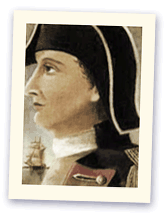 |
 | |||
 The 1798 RisingThe Society of United Irishmen was founded in Belfast in 1791. Its inspiration was a young Dublin lawyer, Theobald Wolfe Tone, who was invited to Ulster after publishing a pamphlet entitled "An argument on behalf of the Catholics of Ireland". Northern Presbyterians also suffered from religious discrimination, though less severely, and had absorbed republican ideas from the American and French revolutions. With the formation of a Dublin society, pressure for reform grew, and relief acts were passed in 1792 and 1793. However, Tone sought revolution rather than reform, and hoped for French help in severing the link with Great Britain. After Britain and France went to war in 1793, the United Irishmen came under increasing pressure from the government. Tone chose exile in America in preference to being prosecuted for treason, and the United Irishmen evolved into a secret society bound by revolutionary oaths. of the Catholics of Ireland". Northern Presbyterians also suffered from religious discrimination, though less severely, and had absorbed republican ideas from the American and French revolutions. With the formation of a Dublin society, pressure for reform grew, and relief acts were passed in 1792 and 1793. However, Tone sought revolution rather than reform, and hoped for French help in severing the link with Great Britain. After Britain and France went to war in 1793, the United Irishmen came under increasing pressure from the government. Tone chose exile in America in preference to being prosecuted for treason, and the United Irishmen evolved into a secret society bound by revolutionary oaths.
Returning to Europe in 1796, Tone persuaded the French to invade Ireland, but bad weather prevented a landing. Despite this setback, the United Irishmen continued to recruit members, particularly among disaffected Catholic peasants. Meanwhile, the government had passed an act providing for harsh measures against those who held illegal arms or administered illegal oaths. An army under General Lake conducted an oppressive campaign to disarm Ulster, seen as the most dangerous province. The government had many informers among the United Irishmen, and in March 1798 most of the Leinster leaders were arrested in Dublin. The only leader of the United Inshmen with military experience, Lord Edward Fitzgerald, was captured on 19 May, four days before the date fixed for the rising. Apart from some short-lived but bloody skirmishes in towns and villages west of Dublin, the rising was confined to the northern counties of Antrim and Down, and to County Wexford. The Wexford rising, which began on 26 May, was a spontaneous and frightened response to the cruel measures of magistrates searching for arms and conspirators, but the rebels in turn committed acts of great savagery.
> > > Read the concluding part of this article.
|
[ Back to top ]
All Material © 1999-2018 Irelandseye.com and contributors
